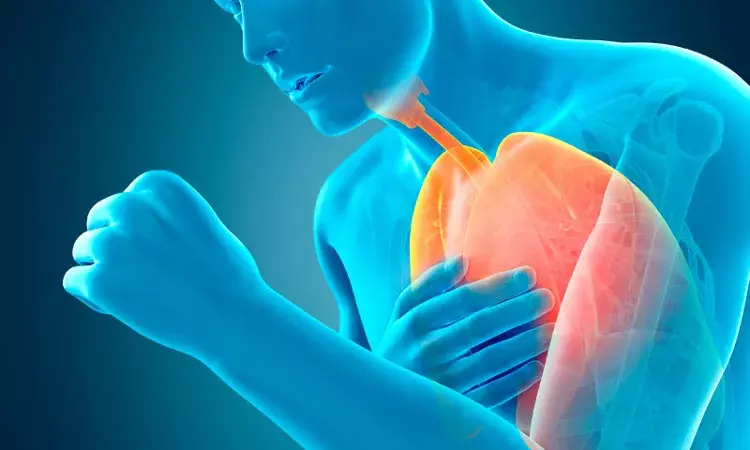- Home
- Medical news & Guidelines
- Anesthesiology
- Cardiology and CTVS
- Critical Care
- Dentistry
- Dermatology
- Diabetes and Endocrinology
- ENT
- Gastroenterology
- Medicine
- Nephrology
- Neurology
- Obstretics-Gynaecology
- Oncology
- Ophthalmology
- Orthopaedics
- Pediatrics-Neonatology
- Psychiatry
- Pulmonology
- Radiology
- Surgery
- Urology
- Laboratory Medicine
- Diet
- Nursing
- Paramedical
- Physiotherapy
- Health news
- Fact Check
- Bone Health Fact Check
- Brain Health Fact Check
- Cancer Related Fact Check
- Child Care Fact Check
- Dental and oral health fact check
- Diabetes and metabolic health fact check
- Diet and Nutrition Fact Check
- Eye and ENT Care Fact Check
- Fitness fact check
- Gut health fact check
- Heart health fact check
- Kidney health fact check
- Medical education fact check
- Men's health fact check
- Respiratory fact check
- Skin and hair care fact check
- Vaccine and Immunization fact check
- Women's health fact check
- AYUSH
- State News
- Andaman and Nicobar Islands
- Andhra Pradesh
- Arunachal Pradesh
- Assam
- Bihar
- Chandigarh
- Chattisgarh
- Dadra and Nagar Haveli
- Daman and Diu
- Delhi
- Goa
- Gujarat
- Haryana
- Himachal Pradesh
- Jammu & Kashmir
- Jharkhand
- Karnataka
- Kerala
- Ladakh
- Lakshadweep
- Madhya Pradesh
- Maharashtra
- Manipur
- Meghalaya
- Mizoram
- Nagaland
- Odisha
- Puducherry
- Punjab
- Rajasthan
- Sikkim
- Tamil Nadu
- Telangana
- Tripura
- Uttar Pradesh
- Uttrakhand
- West Bengal
- Medical Education
- Industry
Role of Procalcitonin in Mechanically Ventilated Patients of COPD with respiratory failure

CHINA: According to a report published in the International Journal of Chronic Obstructive Pulmonary Disease, the detection of procalcitonin can direct the choice of ventilation switching points in sequential mechanical ventilation therapy for patients with COPD experiencing respiratory failure in the acute exacerbation stage.
Among senior adults, chronic obstructive pulmonary disease (COPD) is one of the most prevalent respiratory disorders.
"Admission to an intensive care unit (ICU) for monitoring and mechanical ventilation treatment is one of the most crucial aspects of clinical treatment for patients with an acute exacerbation of COPD coupled with respiratory failure. The most frequent form of treatment for acute respiratory failure and COPD exacerbation is sequential mechanical ventilation, which has been shown in clinical studies to be significantly more effective and safer than traditional mechanical ventilation, "the team lead by Fang Ding, Department of Geriatrics, Hengshui People's Hospital, asserted.
The smooth and safe transition from invasive mechanical ventilation to non-invasive ventilation, however, is a crucial therapeutic concern.
The authors intended to evaluate the procalcitonin (PCT) guiding value for the selection of ventilation switching points in sequential mechanical ventilation for patients with acute exacerbations of chronic obstructive pulmonary disease (COPD) and respiratory failure, and to serve as a guide for the optimization of mechanical ventilation for patients with COPD and respiratory failure.
The trial enrolled 160 patients who had sequential mechanical ventilation therapy for a COPD acute exacerbation complicated by respiratory failure. Two groups of 80 people each were created among them. For sequential mechanical ventilation treatment in the control group, the critical point of the pulmonary infection observation window (PIC) was employed as the switching point, but for sequential mechanical ventilation treatment in the observation group, the PCT clinical node was used. Intense care unit (ICU) treatment time, non-invasive mechanical ventilation time, total mechanical ventilation time, complication rate, and prognosis were compared for the two groups.
Key highlights of the study:
- After one day of treatment, there was no discernible difference between the two groups in terms of respiratory rate, heart rate, arterial systolic pressure, arterial oxygen partial pressure, arterial carbon dioxide partial pressure, or pH value.
- There were substantial differences between the two groups in terms of invasive mechanical ventilation time, non-invasive mechanical ventilation time, total mechanical ventilation time, ICU treatment time, and the occurrence of complications (P = 0.0001).
- In both the control and observation groups, the death rate was 6.25%, and there was no statistically significant difference in the prognosis between the two groups (P > 0.05).
- In comparison to the control group, the observation group's complication rate was decreased (P< 0.05).
The researchers concluded that detecting PCT can efficiently reduce the misvaluation of PIC switching points, allowing patients to establish stable standards of judgment and efficiently enhancing the effectiveness and safety of mechanical ventilation treatment for patients in the acute exacerbation stage.
REFERENCE
Ding F, Liu W, Wang H, Wang W, Yang C. Guidance Value of Procalcitonin Detection in Selecting Switching Points for Sequential Therapy in Patients with Acute Exacerbation of Chronic Obstructive Pulmonary Disease Complicated by Respiratory Failure. Int J Chron Obstruct Pulmon Dis. 2022;17:2693-2699 https://doi.org/10.2147/COPD.S366028
Dr Kamal Kant Kohli-MBBS, DTCD- a chest specialist with more than 30 years of practice and a flair for writing clinical articles, Dr Kamal Kant Kohli joined Medical Dialogues as a Chief Editor of Medical News. Besides writing articles, as an editor, he proofreads and verifies all the medical content published on Medical Dialogues including those coming from journals, studies,medical conferences,guidelines etc. Email: drkohli@medicaldialogues.in. Contact no. 011-43720751


